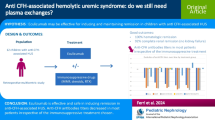Abstract
Patients with autoimmune hemolytic anemia (AIHA) may require intensive care unit (ICU) admission. In order to describe the characteristics of AIHA patients in ICU and identify prognosis factors, clinical and biological data from 44 patients admitted in one ICU between 2002 and 2015 were retrospectively analyzed. The main reasons for ICU admission were profound anemia without any organ failure in 19 patients (either for safer transfusion or continuous monitoring only). Twenty-five (57%) patients had a past history of hemopathy. Twenty patients presented with a direct anti-globulin test (DAT) positive for immunoglobulin G (DAT-IgG) only (46%), 8 with a DAT positive for both IgG and complement (DAT-IgG+C) (36%), and 16 with a DAT positive for complement only (DAT-IgG+C) (18%). Corticosteroids and rituximab were administered to respectively 44 (100%) and 12 (25%) patients. Red blood cell transfusion was required in 28 (64%) patients. Ten (23%) patients received vasopressors. Renal replacement therapy was necessary in 14 (31.8%) patients. Thirteen (30%) patients died in the ICU. There was no difference between survivors and non-survivors regarding associated comorbidities like hemopathy (18/31 [58%] vs. 7/13 [54%], p = 0.80). In decedents, age was higher (72 years [57.8–76.3] vs. 50 years [34.3–64], p < 0.01) and organ dysfunctions were more severe at day 1 (SOFA 8 [7–11] vs. 5.5 [3–7], p < 0.01). Patients with a DAT-IgG displayed poorer outcome in comparison with patients with DAT-IgG+C/C (hospital mortality 69% vs. 36%, p = 0.04). Mortality rate of AIHA patients requiring ICU admission is consequential and appears to be impacted by age, organ failures, and DAT-IgG.


Similar content being viewed by others
References
Gehrs BC, Friedberg RC (2002) Autoimmune hemolytic anemia. Am J Hematol 69(4):258–271
Michel M (2011) Classification and therapeutic approaches in autoimmune hemolytic anemia: an update. Expert Rev Hematol 4(6):607–618
Moreno C, Hodgson K, Ferrer G, Elena M, Filella X, Pereira A, Baumann T, Montserrat E (2010) Autoimmune cytopenia in chronic lymphocytic leukemia: prevalence, clinical associations, and prognostic significance. Blood 116(23):4771–4776
Roumier M, Loustau V, Guillaud C, Languille L, Mahevas M, Khellaf M, Limal N, Noizat-Pirenne F, Godeau B, Michel M (2014) Characteristics and outcome of warm autoimmune hemolytic anemia in adults: new insights based on a single-center experience with 60 patients. Am J Hematol 89(9):E150–E155
Knaus WA, Zimmerman JE, Wagner DP, Draper EA, Lawrence DE (1981) APACHE-acute physiology and chronic health evaluation: a physiologically based classification system. Crit Care Med 9(8):591–597
Vincent JL, Moreno R, Takala J, Willatts S, De Mendonça A, Bruining H et al (1996) The SOFA (sepsis-related organ failure assessment) score to describe organ dysfunction/failure. On behalf of the working group on sepsis-related problems of the European Society of Intensive Care Medicine. Intensive Care Med 22(7):707–710
Le Gall JR, Lemeshow S, Saulnier F (1993) A new simplified acute physiology score (SAPS II) based on a European/north American multicenter study. JAMA 270(24):2957–2963
Lengliné E, Raffoux E, Lemiale V, Darmon M, Canet E, Boissel N, Schlemmer B, Dombret H, Azoulay E (2012) Intensive care unit management of patients with newly diagnosed acute myeloid leukemia with no organ failure. Leuk Lymphoma 53(7):1352–1359
Barcellini W, Fattizzo B, Zaninoni A, Radice T, Nichele I, Di Bona E et al (2014) Clinical heterogeneity and predictors of outcome in primary autoimmune hemolytic anemia: a GIMEMA study of 308 patients. Blood 124(19):2930–2936
Barcellini W, Zaja F, Zaninoni A, Imperiali FG, Battista ML, Di Bona E et al (2012) Low-dose rituximab in adult patients with idiopathic autoimmune hemolytic anemia: clinical efficacy and biologic studies. Blood 119(16):3691–3697
Aladjidi N, Leverger G, Leblanc T, Picat MQ, Michel G, Bertrand Y, Bader-Meunier B, Robert A, Nelken B, Gandemer V, Savel H, Stephan JL, Fouyssac F, Jeanpetit J, Thomas C, Rohrlich P, Baruchel A, Fischer A, Chene G, Perel Y, for the Centre de Reference National des Cytopenies Auto-immunes de l'Enfant (CEREVANCE) (2011) New insights into childhood autoimmune hemolytic anemia: a French national observational study of 265 children. Haematologica 96(5):655–663
Author information
Authors and Affiliations
Corresponding author
Ethics declarations
The study was performed in accordance with the ethical standards of the Helsinki Declaration and was approved by our local institutional review board.
Conflict of interest
The authors declare that they have no conflict of interest.
Rights and permissions
About this article
Cite this article
Lafarge, A., Bertinchamp, R., Pichereau, C. et al. Prognosis of autoimmune hemolytic anemia in critically ill patients. Ann Hematol 98, 589–594 (2019). https://doi.org/10.1007/s00277-018-3553-9
Received:
Accepted:
Published:
Issue Date:
DOI: https://doi.org/10.1007/s00277-018-3553-9




